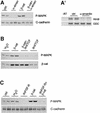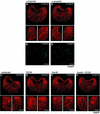A role for maternal beta-catenin in early mesoderm induction in Xenopus
- PMID: 12839992
- PMCID: PMC165652
- DOI: 10.1093/emboj/cdg328
A role for maternal beta-catenin in early mesoderm induction in Xenopus
Abstract
Mesoderm formation results from an inducing process that requires maternal and zygotic FGF/MAPK and TGFbeta activities, while maternal activation of the Wnt/beta-catenin pathway determines the anterior-dorsal axis. Here, we show a new role of Wnt/beta-catenin signaling in mesoderm induction. We find that maternal beta-catenin signaling is not only active dorsally but also all around the equatorial region, coinciding with the prospective mesoderm. Maternal beta-catenin function is required both for expression of dorsal genes and for activation of MAPK and the mesodermal markers Xbra and eomesodermin. beta-catenin acts in a non- cell-autonomous manner upstream of zygotic FGF and nodal signals. The Wnt/beta-catenin activity in the equatorial region of the early embryo is the first example of a maternally provided mesoderm inducer restricted to the prospective mesoderm.
Figures







Similar articles
-
The Wnt/beta-catenin pathway posteriorizes neural tissue in Xenopus by an indirect mechanism requiring FGF signalling.Dev Biol. 2001 Nov 1;239(1):148-60. doi: 10.1006/dbio.2001.0431. Dev Biol. 2001. PMID: 11784025
-
Nodal signaling in Xenopus gastrulae is cell-autonomous and patterned by beta-catenin.Dev Biol. 2003 Jan 1;253(1):125-38. doi: 10.1006/dbio.2002.0867. Dev Biol. 2003. PMID: 12490202
-
Zygotic Wnt/beta-catenin signaling preferentially regulates the expression of Myf5 gene in the mesoderm of Xenopus.Dev Biol. 2002 May 1;245(1):124-35. doi: 10.1006/dbio.2002.0633. Dev Biol. 2002. PMID: 11969260
-
Pluripotent cells (stem cells) and their determination and differentiation in early vertebrate embryogenesis.Dev Growth Differ. 2001 Oct;43(5):469-502. doi: 10.1046/j.1440-169x.2001.00599.x. Dev Growth Differ. 2001. PMID: 11576166 Review.
-
New steps in the Wnt/beta-catenin signal transduction pathway.Recent Prog Horm Res. 2000;55:225-36. Recent Prog Horm Res. 2000. PMID: 11036939 Review.
Cited by
-
Xenopus Nkx6.3 is a neural plate border specifier required for neural crest development.PLoS One. 2014 Dec 22;9(12):e115165. doi: 10.1371/journal.pone.0115165. eCollection 2014. PLoS One. 2014. PMID: 25531524 Free PMC article.
-
Interaction of Sox1, Sox2, Sox3 and Oct4 during primary neurogenesis.Dev Biol. 2011 Feb 15;350(2):429-40. doi: 10.1016/j.ydbio.2010.12.013. Epub 2010 Dec 11. Dev Biol. 2011. PMID: 21147085 Free PMC article.
-
Agonistic and antagonistic roles for TNIK and MINK in non-canonical and canonical Wnt signalling.PLoS One. 2012;7(9):e43330. doi: 10.1371/journal.pone.0043330. Epub 2012 Sep 11. PLoS One. 2012. PMID: 22984420 Free PMC article.
-
Reproducible, ultra high-throughput formation of multicellular organization from single cell suspension-derived human embryonic stem cell aggregates.PLoS One. 2008 Feb 13;3(2):e1565. doi: 10.1371/journal.pone.0001565. PLoS One. 2008. PMID: 18270562 Free PMC article.
-
The tumor-associated EpCAM regulates morphogenetic movements through intracellular signaling.J Cell Biol. 2010 Nov 1;191(3):645-59. doi: 10.1083/jcb.201004074. Epub 2010 Oct 25. J Cell Biol. 2010. PMID: 20974811 Free PMC article.
References
-
- Amaya E., Musci,T.J. and Kirschner,M.W. (1991) Expression of a dominant negative mutant of the FGF receptor disrupts mesoderm formation in Xenopus embryos. Cell, 66, 257–270. - PubMed
-
- Angerer L.M. and Angerer,R.C. (2000) Animal–vegetal axis patterning mechanisms in the early sea urchin embryo. Dev. Biol., 218, 1–12. - PubMed
-
- Cadigan K. and Nusse,R. (1997) Wnt signaling: a common theme in animal development. Genes Dev., 11, 3286–3305. - PubMed
-
- Campione M. et al. (1999) The homeobox gene Pitx2: mediator of asymmetric left–right signaling in vertebrate heart and gut looping. Development, 126, 1225–1234. - PubMed
MeSH terms
Substances
LinkOut - more resources
Full Text Sources
Other Literature Sources

